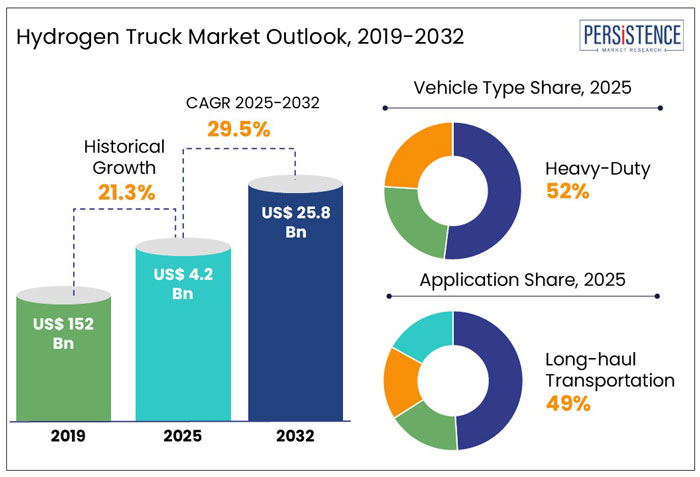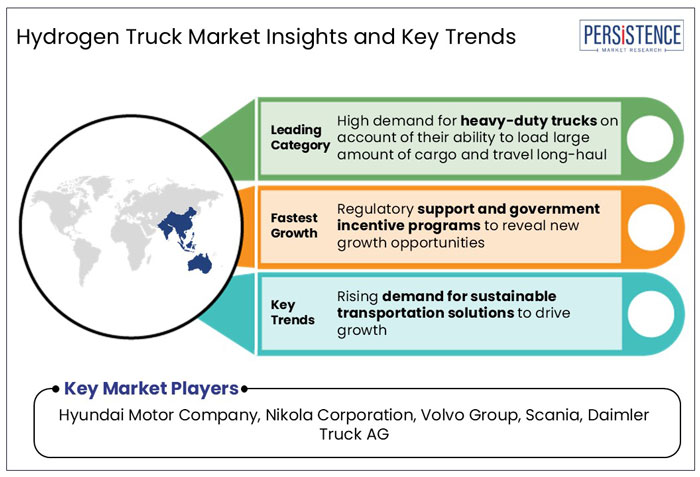Industry: Chemicals and Materials
Published Date: April-2025
Format: PPT*, PDF, EXCEL
Delivery Timelines: Contact Sales
Number of Pages: 190
Report ID: PMRREP35186
The global hydrogen truck market is estimated to grow from US$ 4.2 Bn in 2025 to US$ 25.8 Bn by 2032. The market is projected to record a CAGR of 29.5% during the forecast period from 2025 to 2032.
According to Persistence Market Research (PMR), the market is likely to witness substantial growth due to the growing preference for hydrogen powered vehicle over traditional combustion vehicles in transportation & logistics sector. Besides, supportive government policies and investments by companies in the development of hydrogen refueling infrastructures are anticipated to surge the demand for hydrogen trucks in coming time. For instance, the U.S. Bipartisan Infrastructure Law allocates funds for developing regional hydrogen hubs, which include investments in pipelines, refueling stations, and storage facilities.

Key Industry Highlights:
|
Global Market Attributes |
Key Insights |
|
Hydrogen Truck Market Size (2025E) |
US$ 4.2 Bn |
|
Market Value Forecast (2032F) |
US$ 25.8 Bn |
|
Projected Growth (CAGR 2025 to 2032) |
29.5% |
|
Historical Market Growth (CAGR 2019 to 2024) |
21.3% |
The rising concern of climate change and air pollution is driving the demand for zero emission vehicles globally. Hydrogen fuel cell trucks emit only water vapor and heat as byproducts, which significantly reduces air pollution and greenhouse gas emissions. Unlike traditional combustion fuels, hydrogen is produced using renewable energy sources such as solar or wind power. This ‘green hydrogen’ aids in reducing the overall carbon footprint. Green hydrogen helps to reduce emissions by over 85% compared to diesel trucks.
Hydrogen-powered trucks offer promising solutions for sustainable transportation by enhancing operational efficiency, reducing emissions, and supporting transition to renewable energy sources. Therefore, the rising demand for sustainable mobility solutions in transportation sector is anticipated to support market growth in the forthcoming years.
Hydrogen-powered trucks are manufactured for longer or continual metro-regional applications. Despite their impressive specifications, these trucks come with practical challenges such as high operational cost, weight limitations, fuel costs, and warranty concerns. For instance, these trucks cost five to ten time more than diesel-powered vehicles, with additional Federal Excise Tax (FET) and local sales tax. Besides, high cost of hydrogen significantly increases the fuel consumption cost. In California, the price ranges from US$ 13 to US$ 16 per kilogram at refueling stations.
High maintenance cost compared to other combustive vehicles is another factor leading to the overall ownership cost of the vehicle. Such factors, are thereby, anticipated to limit the growth of the market to a certain extent.
Regulatory support and incentives play an important role in promoting the adoption of hydrogen-powered trucks. For instance, the Inflation Reduction Act (IRA) introduced a tax credit of up to US$ 3 per kilogram for clean hydrogen production. This move has ensured more economic viability for companies to invest in hydrogen projects. In addition, the IRA also extends and increases tax credits for alternative fuel refueling infrastructure, including hydrogen stations.
The U.S. Department of Energy is funding the development of regional hydrogen hubs, which include infrastructure for transportation use. This initiative aims to increase green hydrogen production and support its deployment in the transportation sector. As a result, supportive government regulations to promote sustainable transportation sector are projected to favor the growth of the market through 2032.
Hydrogen fuel cells offer reliable, efficient, and eco-friendly solutions for various applications in transportation sector. Companies are collaborating with others to develop advanced fuel cells that help to improve reaction rates and reduce fuel crossover, which helps in increasing power output and efficiency. Such initiatives are likely to provide ample growth opportunities for automotive players in the market.
For instance, in March 2025, Advent Technologies Holdings, Inc., a prominent player in the fuel cell and hydrogen technology space, announced the commencement of its Phase Two of Hydrogen Fuel Cell Benchmarking Project, in collaboration with Airbus, a leading aircraft manufacturer. The companies are jointly developing optimized Ion Pair Membrane Electrode Assembly (MEA) for hydrogen fuel cells. The project aims to accelerate the development of Advent’s MEA against aviation requirements of optimal working of future hydrogen-fueled planes.
On the basis of vehicle type, the heavy-duty trucks segment is likely to dominate and hold a share of about 52% in 2025. There is a high demand for hydrogen-powered heavy-duty trucks in the transportation and logistics sector due to their superior energy efficiency and long range capabilities. These trucks offer a driving range of around 300-500 miles and fast refueling times, making them suitable for long-haul and heavy-duty applications. This efficiency is crucial for logistics and freight industries where long-distance travel and quick turnaround times are essential.
On the other hand, the small-duty trucks segment is expected to witness substantial growth during the forecast period. Small-duty trucks are widely used in last-mile deliveries and short distance logistics. The rising demand from construction, e-commerce, and public service sector for small-duty trucks is projected to drive the segmental growth during the forecast period.
Based on application, the long-haul transportation segment is anticipated to hold a share of approximately 49% in 2025. Hydrogen-powered trucks can handle both regional and long-haul routes with long driving range, can refuel faster, and carry more cargo compared to diesel-operated trucks. Besides, government and private companies are focusing on the development of hydrogen refueling infrastructure along major transport routes, which is expected to drive the demand for hydrogen trucks for long-haul applications.

Asia Pacific is expected to hold the largest share of about 41.9% in 2025. The dominance of the region is attributable to supportive government policies, increasing focus on infrastructure development, and increasing investments in research and development activities. Countries such as China, Japan, India, South Korea, and Australia are a part of broader regional initiatives like the Asia Zero Emission Community (AZEC). This initiative aims at collective co-operation with multiple nations to achieve carbon neutrality and net-zero emissions.
China is expected to exert its dominance in the region backed by growing partnerships between OEMs and the government to deploy hydrogen trucks. For example, in 2024, BMW Brilliance partnered with local governments in Shenyang City and Dandong District to promote the use of green hydrogen-fueled trucks. This initiative includes joint construction of hydrogen refueling stations by Sinopec Green Energy, supporting BMW’s efforts to explore sustainability in transportation sector.
On the other hand, India is exploring hydrogen as a part of its broader strategy to reduce emissions. Automotive companies in India are focusing on research and development strategies to develop and introduce advanced hydrogen trucks. For instance, in February 2025, Tata Motors, a prominent commercial vehicle manufacturer, announced the first-ever trials of hydrogen-powered heavy-duty trucks. This historical trail was flagged off by the Union Minister of Road Transport & Highways, Shri Nitin Gadkari and Shri Pralhad Joshi, Union Minister of New and Renewable Energy.
North America is projected to register a considerable growth due to several key factors such presence of established OEM manufacturers such as Kenworth, Freightliner, Peterbilt, and others, rising investments in development of hydrogen refueling infrastructure, and stringent zero-emission vehicle mandates. For example, New York’s Advanced Clean Trucks rule aim to increase zero-emission truck sales. Moreover, technological advancements in hydrogen fuel cell technology are leading to improved efficiency and reduced costs.
Heavy-duty trucks are the largest segment in the U.S. due to their suitability for heavy-duty and long-haul applications. The presence of a solid highway system in the U.S. is anticipated to support increasing adoption of hydrogen-powered trucks. For instance, the Interstate Highway System spans approximately 48,890 miles across the country.
Europe is projected to significant growth during the forecast period. Europe has set ambitious decarbonization targets, including reducing CO2 emissions from transport sector. The European Union’s Fit for 55 package aims to cut emissions by 55% by 2030. This regulatory is likely to encourage the adoption of hydrogen trucks as a zero-emission alternative. Countries such as Germany, the Netherlands, and Spain have established specific targets and incentives for hydrogen fuel cell trucks. For example, Germany aims for 11,000 fuel cell trucks by 2030, while the Netherlands targets 3,000 heavy-duty fuel cell vehicles by 2025.
The competitive landscape for hydrogen trucks market is fragmented. Competitive intelligence is crucial when navigating the hydrogen truck market, which is filled with innovation and characterized by presence of several key players. Companies are differentiating themselves by focusing on investing in research and development activities, turning towards partnerships, strategic joint ventures, and regional expansion. Supportive government policies are encouraging players to develop advanced hydrogen infrastructure, which is likely to support the growth of the market during the forecast period.
|
Report Attributes |
Details |
|
Historical Data/Actuals |
2019 - 2024 |
|
Forecast Period |
2025 - 2032 |
|
Market Analysis |
Value: US$ Mn |
|
Geographical Coverage |
|
|
Segmental Coverage |
|
|
Competitive Analysis |
|
|
Report Highlights |
|
|
Customization and Pricing |
Available upon request |
By Vehicle Type
By Range
By Hydrogen Tank
By Application
By Region
To know more about delivery timeline for this report Contact Sales

The Hydrogen Truck Market size is likely to be US$ 4.2 Bn in 2025.
The industry will likely be valued at US$ 25.8 Bn by 2032.
A few of the leading players in the market are Hyundai Motor Company, Nikola Corporation, Volvo Group, Nikola Corporation, Daimler Truck AG, and others
The industry is estimated to rise at a CAGR of 29.5% through 2032.
Asia Pacific is projected to hold the largest share of the industry in 2025 as well as through the forecast period.